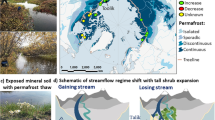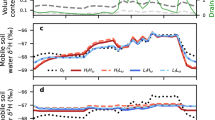Abstract
Water movement in upland humid watersheds from the soil surface to the stream is often described using the concept of translatory flow1,2, which assumes that water entering the soil as precipitation displaces the water that was present previously, pushing it deeper into the soil and eventually into the stream2. Within this framework, water at any soil depth is well mixed and plants extract the same water that eventually enters the stream. Here we present water-isotope data from various pools throughout a small watershed in the Cascade Mountains, Oregon, USA. Our data imply that a pool of tightly bound water that is retained in the soil and used by trees does not participate in translatory flow, mix with mobile water or enter the stream. Instead, water from initial rainfall events after rainless summers is locked into small pores with low matric potential until transpiration empties these pores during following dry summers. Winter rainfall does not displace this tightly bound water. As transpiration and stormflow are out of phase in the Mediterranean climate of our study site, two separate sets of water bodies with different isotopic characteristics exist in trees and streams. We conclude that complete mixing of water within the soil cannot be assumed for similar hydroclimatic regimes as has been done in the past3,4.
This is a preview of subscription content, access via your institution
Access options
Subscribe to this journal
Receive 12 print issues and online access
$259.00 per year
only $21.58 per issue
Buy this article
- Purchase on Springer Link
- Instant access to full article PDF
Prices may be subject to local taxes which are calculated during checkout




Similar content being viewed by others
References
Hewlett, J. D. & Hibbert, A. R. in Forest Hydrology (eds Sopper, W. E. & Lull, H. W.) 275–291 (Pergamon, 1967).
Horton, J. H. & Hawkins, R. H. Flow path of rain from soil surface to water table. Soil Sci. 100, 377–383 (1965).
Bruijnzeel, L. A. (De)forestation and dry season flow in the tropics: A closer look. J. Tropical Forest Sci. 1, 229–243 (1989).
Govind, A., Chen, J. M. & Ju, W. Spatially explicit simulation of hydrologically controlled carbon and nitrogen cycles and associated feedback mechanisms in a boreal ecosystem. J. Geophys. Res. 114, G02006 (2009).
Bates, C. G. First results in the streamflow experiment Wagon Wheel Gap, Colorado. J. Forestry 19, 402–408 (1921).
Bosch, J. M. & Hewlett, J. D. A review of catchment experiments to determine the effect of vegetation changes on water yield and evapotranspiration. J. Hydrol. 55, 3–23 (1982).
Jones, J. A. Hydrologic processes and peak discharge response to forest removal, regrowth, and roads in 10 small experimental basins, western Cascades, Oregon. Wat. Resour. Res. 36, 2621–2642 (2000).
Jones, J. A. & Grant, G. E. Peak flow responses to clear-cutting and roads in small and large basins, western Cascades, Oregon. Wat. Resour. Res. 32, 959–974 (1996).
Alila, Y., Kuras, P. K., Schnorbus, M. & Hudson, R. Forests and floods: A new paradigm sheds light on age-old controversies. Wat. Resour. Res. 45, W08416 (2009).
McDonnell, J. J. et al. Moving beyond heterogeneity and process complexity: A new vision for watershed hydrology. Wat. Resour. Res. 43, W07301 (2007).
Dawson, T. E. & Ehleringer, J. R. Streamside trees that do not use streamside water. Nature 350, 335–337 (1991).
Bond, B. J. et al. The zone of vegetation influence on baseflow revealed by diel patterns of streamflow and vegetation water use in a headwater basin. Hydrol. Process. 16, 1671–1677 (2002).
Seibert, J. & McDonnell, J. J. On the dialog between experimentalist and modeler in catchment hydrology: Use of soft data for multicriteria model calibration. Wat. Resour. Res. 38, 1241 (2002).
Clark, I. D. & Fritz, P. Environmental Isotopes in Hydrogeology (Lewis, 1997).
Dansgaard, W. Stable isotopes in precipitation. Tellus 4, 436–468 (1964).
West, A. G., Patrickson, S. J. & Ehleringer, J. R. Water extraction times for plant and soil materials used in stable isotope analysis. Rapid Commun. Mass Spectrometry 20, 1317–1321 (2006).
Harr, R. D. Water flux in soil and subsoil on a steep forested slope. J. Hydrol. 33, 37–58 (1977).
Selker, J. S., Keller, C. K. & McCord, J. T. Vadose Zone Processes (Lewis, 1999).
Gouet-Kaplan, M., Tartakovsky, A. & Berkowitz, B. Simulation of the interplay between resident and infiltrating water in partially saturated porous media. Wat. Resour. Res. 45, W05416 (2009).
Gazis, C. & Feng, X. A stable isotope study of soil water: Evidence for mixing and preferential flow paths. Geoderma 119, 97–111 (2004).
Gardner, W. R. Some steady state solutions of the unsaturated moisture flow equations with application to evaporation from a water table. Soil Sci. 85, 228–232 (1958).
Brooks, J. R., Meinzer, F. C., Warren, J. M., Domec, J. C. & Coulombe, R. Hydraulic redistribution in a Douglas-fir forest: Lessons from system manipulations. Plant Cell Environ. 29, 138–150 (2006).
Warren, J. M., Meinzer, F. C., Brooks, J. R. & Domec, J. C. Vertical stratification of soil water storage and release dynamics in Pacific Northwest coniferous forests. Agric. For. Meteorol. 130, 39–58 (2005).
Domec, J. C., Warren, J. M., Meinzer, F. C., Brooks, J. R. & Coulombe, R. Native root xylem embolism and stomatal closure in stands of Douglas-fir and ponderosa pine: Mitigation by hydraulic redistribution. Oecologia 141, 7–16 (2004).
McGuire, K. J. et al. The role of topography on catchment-scale water residence time. Wat. Resour. Res. 41, W05002 (2005).
Bundt, M., Jaggi, M., Blaser, P., Siegwolf, R. & Hagedorn, F. Carbon and nitrogen dynamics in preferential flow paths and matrix of a forest soil. Soil Sci. Soc. Am. J. 65, 1529–1538 (2001).
Asano, Y., Compton, J. E. & Church, R. M. Hydrologic flowpaths influence inorganic and organic nutrient leaching in a forest soil. Biogeochem. 81, 191–204 (2006).
Dawson, T. E. in Stable Isotopes and Plant Carbon–Water Relations (eds Ehleringer, J. R., Hall, A. E. & Farquhar, G. D.) 465–496 (Academic, 1993).
Kennedy, V. C., Zellweger, G. W. & Avanzino, R. J. Variation of rain chemistry during storms at two sites in northern California. Wat. Resour. Res. 15, 687–702 (1979).
Acknowledgements
This work was supported by the US Environmental Protection Agency. This manuscript has been subjected to the Environmental Protection Agency’s peer and administrative review, and it has been approved for publication as an EPA document. Mention of trade names or commercial products does not constitute endorsement or recommendation for use. This research was conducted at the H. J. Andrews Experimental Forest, and we thank USDA Forest Service Pacific Northwest Research Station, Oregon State University and the Willamette National Forest for their support of this research facility. H.B. thanks the Oregon State University Institute for Water and Watersheds and the Ford Foundation for financial support. We thank G. Heinz and M. Johnson for help in field work, W. Rugh and K. Rodecap for isotopic analysis, and J. Selker, D. Williams, L. Hopp and R. Ozretich for helpful comments on an earlier draft of this manuscript.
Author information
Authors and Affiliations
Contributions
J.R.B. designed the research plan, obtained financial support, analysed and interpreted the data and wrote the paper. H.B. participated in data collection, analysis and interpretation, and contributed to the writing of the paper. R.C. coordinated sample collection efforts, led field crews and ensured the data quality of all field collections. J.M. advised throughout, assisted with interpretation of the results and contributed to the writing of the paper.
Corresponding author
Ethics declarations
Competing interests
The authors declare no competing financial interests.
Supplementary information
Supplementary Information
Supplementary Information (PDF 327 kb)
Rights and permissions
About this article
Cite this article
Renée Brooks, J., Barnard, H., Coulombe, R. et al. Ecohydrologic separation of water between trees and streams in a Mediterranean climate. Nature Geosci 3, 100–104 (2010). https://doi.org/10.1038/ngeo722
Received:
Accepted:
Published:
Issue Date:
DOI: https://doi.org/10.1038/ngeo722
This article is cited by
-
Elastic deformation as a tool to investigate watershed storage connectivity
Communications Earth & Environment (2024)
-
Soil pore water evaporation and temperature influences on clay mineral paleothermometry
Communications Earth & Environment (2024)
-
Is the amount of water transported by arbuscular mycorrhizal fungal hyphae negligible? Insights from a compartmentalized experimental study
Plant and Soil (2024)
-
The role of geometric properties of ephemeral arid streams in the control of soil and sediment quality, and vegetation canopy distribution: a case study in the southwest of Fars province, Iran
Journal of Soils and Sediments (2023)
-
Impacts of Riparian and Non-riparian Woody Encroachment on Tallgrass Prairie Ecohydrology
Ecosystems (2023)



